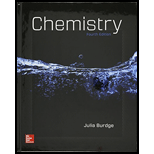
Interpretation: The paramagnetic species among the species
Concept introduction:
The combination of two atomic orbitals results in theformation of a bonding and an antibonding molecular orbital. Orbitals that lie on an internuclear axis combine to form sigma,
molecular orbitals.
The molecular orbital formed by the combination of
Bond order is determined by subtracting the number of antibonding electrons from the number of bonding electrons and dividing the number obtained by two.
If paired electrons are there in the orbital, then species is diamagnetic and if unpaired then it is paramagnetic.
Want to see the full answer?
Check out a sample textbook solution
Chapter 9 Solutions
Chemistry - With Access
- Question 31 sp3-Hybridization of the carbon atom in methane has a total of how many sp3-hybrid orbitals? a) 0 b) 1 c) 2 d) 3 e) 4arrow_forwardThere are 3 isomers of dichlorobenzene, and they are shown below. Which is/are non-polar? Note: Answer A is supposed to be (III Only)arrow_forwardWhich of the following molecules are polar? Pick all correct answer(s). Group of answer choices XeF4 CCl4 ammonia NH3 SF4 CO2arrow_forward
- what bond angle is predicted for a liners molecule? which molecules were linear, did the molecular mechanics calculation product the correct bond angle list includes, CH4, CO2, H2CO, HCN, NH3, H2O, C2H4arrow_forwardPractice: For each of the following four molecules: a) Indicate the hybridization of carbons, oxygen and nitrogen b) Sketch overlapping orbitals c) Identify the bonds (sigma, pi) d) Identify their shapes e) Indicate bond angles f) Discuss bond length and bond strength of each bond CH3CH3 CH3OH CHO HCNarrow_forwardAnswer all parts (A, B, & C) a) Draw the Lewis structure of the nitrate ion, NO3 -, including all resonance forms and formal charges. What is the geometry of the nitrate ion? b) True or False: Because of the double bond in the nitrate ion, two bond angles are greater than 120° and one bond angle is less than 120°. Explain your answer. c) What is the hybridization of the N in nitrate?arrow_forward
- Based on molecular orbital theory, choose the correct statement about B2 Question options: a. Is unstable molecule with bond order of 1/2 and it is diamagnetic b. Is stable molecule with bond order of 1 and it is diamagnetic c. Is unstable molecule with bond order of 2 and it is diamagnetic d. Is unstable molecule with bond order of zero and it is diamagnetic e. Is a stable molecule with bond order is 1 and it is paramagneticarrow_forwardWhich of the following atoms do NOT have 5 valence electrons? Select all that applyarrow_forwardWhich of the following molecules does not have a net dipole moment of zero? Mark all correct answers.arrow_forward
- Which electrostatic potential map best represents the Cl2 molecule? Question 14 options: 2 1 3arrow_forwardStatement 1: Approximately, there is 70 degrees bond angle difference between compound1&2 Statement 2: Furter, an ≈0.34 A difference in their distance can be inferred Which among the statement is true? 1, 2, both, or nonearrow_forwardStatement 1: The geometry formed from the bonding of C and H atoms for Compound 2 is trigonal Statement 2: Meaning, the distance between the two C atoms is closer than Compound 1 Which statement is true? 1, 2, both, or none?arrow_forward
 Chemistry & Chemical ReactivityChemistryISBN:9781133949640Author:John C. Kotz, Paul M. Treichel, John Townsend, David TreichelPublisher:Cengage Learning
Chemistry & Chemical ReactivityChemistryISBN:9781133949640Author:John C. Kotz, Paul M. Treichel, John Townsend, David TreichelPublisher:Cengage Learning Chemistry In FocusChemistryISBN:9781305084476Author:Tro, Nivaldo J., Neu, Don.Publisher:Cengage Learning
Chemistry In FocusChemistryISBN:9781305084476Author:Tro, Nivaldo J., Neu, Don.Publisher:Cengage Learning

